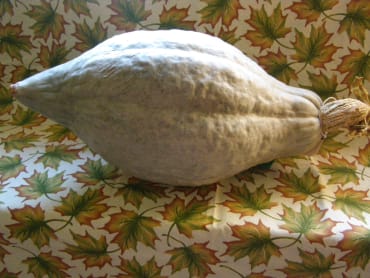(100 days) Open-pollinated. New England strain. Introduced in 1909 by Gregory as Symmes Blue Hubbard, in honor of S.S. Symmes, a gardener who worked for his company for many years. Gregory considered it his best introduction, praising its flavor, productivity and storage qualities. The 1917 Gregory catalog said “close your eyes…and you would think you were eating cake.” Bright yellow-orange dry sweet flesh. Each squash will feed a large family because fruits average 15–20 lb, sometimes exceeding 30 or 40 lb. You may need to split it with an ax. Vines crawl all over the garden. Traditional New England Thanksgiving favorite. Prized also for its large white sweet seeds—delicious roasted. Blue Hubbard has proven effective as a perimeter trap crop for striped cucumber beetles. Completely encircle a main crop of other cucurbits with Hubbard vines, concentrating the pests in the border areas. ② ③
Blue Hubbard
Blue Hubbard
(100 days) Open-pollinated. New England strain. Introduced in 1909 by Gregory as Symmes Blue Hubbard, in honor of S.S. Symmes, a gardener who worked for his company for many years. Gregory considered it his best introduction, praising its flavor, productivity and storage qualities. The 1917 Gregory catalog said “close your eyes…and you would think you were eating cake.” Bright yellow-orange dry sweet flesh. Each squash will feed a large family because fruits average 15–20 lb, sometimes exceeding 30 or 40 lb. You may need to split it with an ax. Vines crawl all over the garden. Traditional New England Thanksgiving favorite. Prized also for its large white sweet seeds—delicious roasted. Blue Hubbard has proven effective as a perimeter trap crop for striped cucumber beetles. Completely encircle a main crop of other cucurbits with Hubbard vines, concentrating the pests in the border areas. ② ③
Additional Information
Hubbard group
About 95 seeds/oz. ⅛ oz packet sows 3 hills.
James J.H. Gregory, who introduced hubbards to commerce around 1850, called them “the acme of perfection in squashdom,” though they now account for only about 5% of New England winter squash sales.
Cucurbita maxima
Green in stems signifies immature fruit. Fat round stems turn corky and woody when the squash is ripe. Fruits tend to be medium to large and often have bumpy surfaces and button-ends. See also large pumpkins: Rouge Vif d’Etampes and Big Max.
Winter Squash
- All open-pollinated except where noted.
- Days to maturity are from direct seeding; subtract 20 days for transplants.
Culture: May be direct-seeded or transplanted. Minimum germination temperature 60°, optimal temperature range 70–90°. Direct seeding: Sow 4–5 seeds per hill when weather has warmed after danger of frost. Allow 4–6' between hills. Thin to 3 best plants. Transplanting: Start indoors three weeks before setting out. Do not disturb the roots. Transplant bush varieties 18" apart, vining varieties 30" apart. For either method, use wire hoops and row covers to hasten maturity and reduce insect damage. Tender, not frost hardy. Heavy nitrogen feeders. Excessive heat and/or drought can prevent blossom set, reduce yields. Winter squash can take one or two light frosts on the vine. To improve flavor and storage, field cure for at least 10 days after harvest, covering if hard frost threatens. Store under proper conditions, at least 50° and 60–70% relative humidity in a place with good air circulation. Do not pile up squash. Inspect periodically and be sure to use damaged, stemless or small fruit first. Acorns have the shortest storage time before getting stringy, followed by delicatas, buttercup/kabochas.
Saving Seed: Saving squash seed is challenging! We list three species of the genus Cucurbita: C. pepo, C. maxima and C. moschata. Varieties of the same species will cross readily, but crossing will not occur between the different species. You must isolate varieties of the same species by half a mile if you want true-to-type seed. This is difficult for most gardeners—you may have to communicate and collaborate with neighboring gardeners, or exclude insects from blossoms and hand-pollinate. If you can pull off the variety isolation, processing the seeds is easy: rinse seeds from the guts of fully ripe and cured squash. Dry and store.
Diseases: BR: Black Rot, PM: Powdery Mildew
Pest: Striped Cucumber Beetle
Cultural controls: use tolerant or resistant varieties, rotate crops, till under crop debris soon after harvest, use floating row covers until flowers appear, use plastic mulch, perimeter trap cropping (Black Zucchini and Blue Hubbard make particularly good trap crops), use yellow sticky strips, hand-pick early morning when beetles are very sluggish.
Materials: Surround, Pyrethrum (PyGanic).
Pest: Squash Bug
Cultural controls: rotation, till in cucurbit debris before winter and plant a cover crop, boards on soil surface near squash will attract bugs overnight which can be killed, avoid mulching. Squash bugs lay their brown-brick red egg clusters on the underside of the foliage, often next to the central vein—destroy egg clusters on undersides of leaves.
Materials: Pyrethrum on young nymphs, AzaMax.
Pest: Squash Vine Borer
Cultural controls: butternut squash is resistant, maximas & pepos susceptible; rotation, plow in squash vine debris soon after harvest, use floating row covers, watch for wilting plant parts and destroy borer within.
Disease: Powdery Mildew
Controls: Use small plots to slow spread, plant indeterminate (viney) varieties, control weed competition.
Materials: sulfur and whole milk, mineral or other oils in combination with potassium bicarbonate.
Disease: Bacterial Wilt
Cultural control: Striped Cucumber Beetle is vector—control it; choose resistant varieties.
Germination Testing
For the latest results of our germination tests, please see the germination page.
Our Seeds are Non-GMO

All of our seeds are non-GMO, and free of neonicotinoids and fungicides. Fedco is one of the original companies to sign the Safe Seed Pledge.




